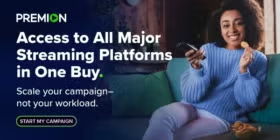

Coinciding with the launch of a new Penthera white paper, Candace Bryan offers insights into the build-or-buy download conversation.
The average OTT viewer spends over 100 minutes in OTT apps across a variety of devices each day—CTVs, laptops, and smartphones and tablets. As the list of OTT providers grows ever longer and the industry more competitive, providers know they have to facilitate a flawless experience across all platforms. That includes mobile, which accounts for 24% of all viewing time happening on mobile devices globally (Conviva).
Each platform has unique challenges, but the mobile video experience can be the most difficult to perfect. That’s because mobile viewers are at a high risk for last mile issues. OTT providers rely on Content Delivery Networks (CDNs) to help get content close to viewers for fast and seamless viewing, but the journey from the CDN’s edge to the device can result in problems when viewers hit play. Mobile devices often rely on congested WiFi or mobile networks and are subject to constant movement, meaning mobile viewers frequently encounter last mile issues like start up delays, buffering and low video quality. That’s why, according to Penthera’s global data, 90% of viewers are frustrated by the mobile video experience.
To solve this, many OTT providers are adding a download feature to their apps: to help users circumvent last mile issues by pushing the edge all the way to the device. This allows viewers to essentially stream locally from their smartphone or tablet, which results in a more seamless experience, increased engagement, and longer mobile session times.
Yet implementing and maintaining download technology can be difficult, with technical and experiential complexities that require a deep understanding of how viewers use downloading. It’s critical that you nail the first impression you get with users’ experience on each device, so providers who are looking to add downloading must weigh the risks of building the feature in-house versus hiring a SAAS company that already has downloading technology.
Here are 3 factors to consider when deciding whether to have your own engineers build a download feature from the ground up or to invest in buying the technology from a trusted provider. To get even more insight, check out our full white paper: Build vs. Buy: Key Factors to Consider Before Implementing Download.
BUILDING A DOWNLOAD ENGINE IS SURPRISINGLY COMPLEX
DIY download entails much more than simply enabling a basic downloading feature. For one, your engineers will need to implement permissions (the set of rules that govern issues like what specific user devices can download, how often a title can be downloaded, or when downloads should be remotely deleted), which is especially important if you work with content that is not owned in-house.
For services with mostly brokered content, permissions can get extremely complex, as various content on the app may be subject to different rules depending on exactly how the service is allowed to distribute it. It also requires deep knowledge of user behavior with downloading, as there are countless scenarios that need to be accounted for with permissions, such as download failures and managing across multiple downloading devices per account.
For DRM protected content, integrations can be more complicated. DRM is designed to ensure your content is only accessed by authorized users, and adding download means that protection needs to work in offline or limited connectivity environments. A common result of a poorly implemented DRM integration is that customers will not be able to playback their content even though it’s been downloaded to their device.
Handling all these complexities of downloading will take a lot of time—time that providers can’t afford to lose when increasing engagement and reducing churn are critical to beating the competition for viewers’ time and money.
FEATURE MAINTENANCE TAKES TIME AND RESOURCES
Building a download engine is not a one and done endeavor. Support, improvements, and performance monitoring will take engineering resources long after the feature itself is built.
The mobile ecosystem is constantly evolving, and every iOS and Android update requires updating your download software. There is added complexity with Android, whose open-source software and 10-year history means that there are thousands of different devices using the system in countless different ways. When building a download engine, you’ll need to account for all these Android devices, and years of Android and iOS versions. That means that in order to set up download, your engineers have a lot of work to do before you can launch.
When you buy from a reliable provider, however, they will have the engine already built and tested to account for past versions of operating systems, with a team dedicated to updating the software as new iOS and Android versions are released.
THE COST OF BUILDING DOWNLOAD FEATURES IN HOUSE
Building download in-house comes with a significant amount of risk that can result in a loss of revenue: if you implement download poorly, you will create a frustrating user experience that results in churn and negative reviews. In fact, slow downloads, frequent download restarts, and expired licenses that lead to an inability to play content are common complaints in negative reviews of apps with poorly implemented download.
Plus, for OTT providers, the time in-house engineers spend on a download feature translates directly to dollars. Engineers have other things to work on and constant fires to put out. Outsourcing download not only saves time and resources so your engineers can stay focused on other projects, it also makes sure your downloading feature stays current and evolves.
Digital TV Research has predicted a surge in mobile-first OTT subscriptions.The number of global SVOD subscriptions is expected to grow from 642 million in 2019 to 1.16 billion in 2025, and 40% of new signups will be handled by mobile—60% happening directly through an SVOD app, and 40% from mobile operators (Digital TV Research).
That means the mobile experience is your first impression, and a poor downloading feature can negatively impact that impression. Buying download technology eliminates that risk and ensures that mobile subscribers can enjoy watching without interruptions. By facilitating a great experience on mobile, and across all platforms where viewers watch, you’ll make sure your users never have a reason to abandon your service for a competitor. And you can continue to thrive in the streaming wars.







